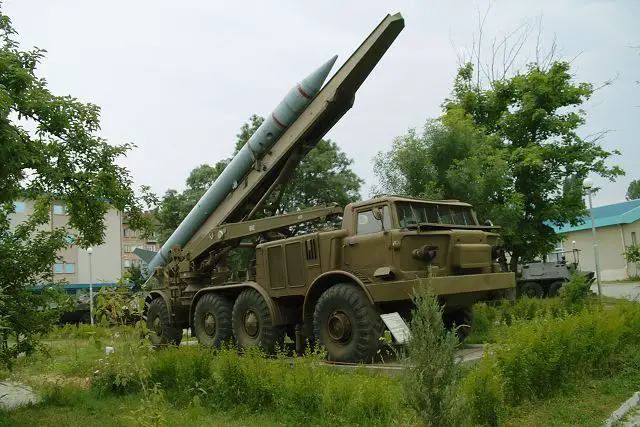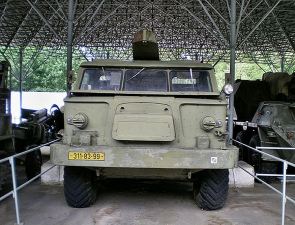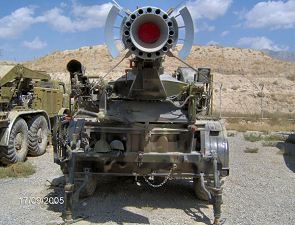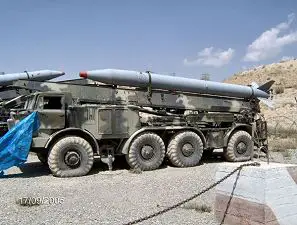|
| |
|
|
| |
| Description |
|
The Frog-7 (Russian name: 9K52 Luna-M ) is a Russian short-range ballistic missile complex. Luna-M missiles are unguided and spin-stabilized. "9K52" is its GRAU designation. There are two variants, the FROG-7A which was first introduced in 1965 as a replacement for earlier FROG variants, some of which had been in service since the mid-1950s. The FROG-7b was introduced in 1968 is based on the R-70 or Luna-Z rocket with a longer warhead section increasing overall length from 8.96 m to 9.4 m. This was fitted with a pair of air brakes that could be locked open to reduce rocket's range. The accuracy of this rocket was less than of the FROG-7a, who figure is 400 - 600 m, and thus did not enter major service. The FROG-7 was replaced by the SS-21 tactical ballistic missile which has greater range (120 km) as well as probable improvements in reaction time, missile reliability, accuracy, and handling characteristics.
|
| |
|
Variants :
|
|
- FROG-7a: Nuclear-armed variant, fitted with a 500-kg (1,213-lb) warhead.
- FROG-7b: This variant is fitted with a 390-kg (860-lb) warhead.
- Laith-90: Iraqi version with increased range (90 km) and subammunition warhead
|
|
|
|
|
|
| |
| Back to top |
| Launcher unit |
|
The carrier vehicle of the FROG-7 missile is the ZIL-135 truck wheeled prime mover, with an onboard crane for rapid load. Cross-country performance is a good as the PT-76 used for the FROG-1, except for the lack of an amphibious capability. The sophisticated ZIL-135 transporter - erector is totally self-contained. In firing position, jacks at the rear and on the sides of the truck are lowered to give a stable launch platform.
|
| Missile |
|
The FROG is an unguided missile, essentially a long-range artillery system. The rocket is of conventional single-stage design, with a cylindrical warhead of the same diameter as the rocket body, giving it a cleaner, more modern appearance than its predecessors. The FROG-7 missile has a range of 70 km and a 550 kg warhead, and an impact area of approximately 2.8 km long by 1.8 km wide. The missile is capable of delivering HE, nuclear, or chemical warheads. Two variants of the FROG-7 were fielded. The FROG-7A series included the 9M21F rocket with a conventional warhead filled with 200 kg oh HE charge, 9M21B with three types of nuclear warhead with yields in the range 3,200 kT, 9M21G with a chemical warhead (VX persistent nerve or other agents), 9M21A with a leaflet warhead carrying 4.5 kg anti-personnel sub-munitions.
|
| Command and control radar |
|
Each FROG-7 battery also has a trailer-carried D-band RMS (NATO name: END TRAY) long-range meteorological radar and a battery command-post vehicle GAZ-66.
|
| Combat use |
|
A typical FROG-7 battalion is equipped with two firing batteries each with two TELs and a D-band RMS (END TRAY) long-range meteorological radar. The cruising range of the transporter-erector-launcher vehicle is 400 km. The FROG-7 TEL vehicle provides no NBC protection for the crew. The single-rail launcher has limited traverse. The accuracy of the launch depends upon the ability of the rocket to fly straight. As the early rocket systems were unstable, they possessed extremely poor accuracy and required nuclear warheads to compensate. The main drawback of the FROG is that its range is insufficient to effectively engage strategic targets, as conventional forces would most likely intercept the launchers before they could move within range. However, the mobile launchers allow the system to keep up with frontline infantry units.
|
| |
| Specifications |
|
|
| |
|
Type of missile
|
|
short range ballistic missile
|
|
Country users
|
|
Algeria, Afghanistan, Belarus, Bulgaria, Czech Republic, Egypt, Libya, Poland, Romania, Yemen
|
|
Launcher
|
|
mobile truck transporter - erector - launcher
|
|
Warhead
|
|
- FROG-7a: 450 kg HE, 450 kg nuclear, or 36 kg chemical warheads
- FROG-7b: Nuclear 3-200 kT, HE, chemical, submunitions
|
|
Crew
|
|
4
|
|
|
Vehicle weight
|
|
25,300 kg
|
|
Effective range
|
|
15 - 68 km
a
|
|
Accuracy
|
|
It has an impact area of approximately 2.8 km long by 1.8 km wide
|
|
Radar and command post vehicle
|
|
END TRAY : long-range meteorological radar
GAZ-66: Command post vehicle
a
a
|
|
Dimensions vehicle
|
|
Length, 10.78 m; Width, 2,83 m; Height, 3,50 m
|
|
|
|
|
|
|
| |
|
|
|
|
|

































